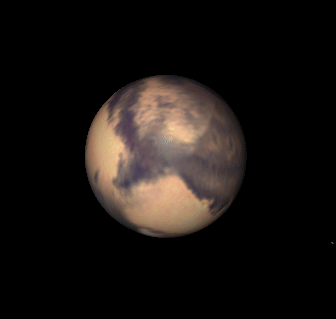I'm Missing It
I did however manage to find a splendid animated GIF file that shows the rotation of Mars as captured during the 2005 opposition. In this GIF you can clearly see Phobos, the larger of Mars' two moons orbiting the planet and if you watch closely you'll also see Deimos, Mars' smaller moon.
Unless the weather gods smile on me I may have to live vicariously through the lenses of others. Such are the frustrations of the amateur astronomer.
For now have a look at this truly amazing image of Mars. Note: click it to go to the photographer's site, there you can view his latest images from the current Mars opposition.
Since we have this amazing picture showing Phobos orbiting Mars perhaps I'll take a little time to tell you about this little moon. Phobos is a midget among the moons in the solar system. Phobos is about 12 miles in diameter, but that measurement varies wildly because it isn't even spherical in shape. It orbits Mars at an astoundingly low altitude of 3700 miles above the Martian surface. No other moon in the solar system orbits so close to its parent planet. Because Phobos orbits so close to Mars' surface, it moves across the Martian sky at an astounding speed; taking only 4 hours to traverse from the western horizon to the east. Seen from the surface, Phobos would rise and set twice a day.
Phobos was discovered on August 18th 1877 at the US Naval observatory by Asaph Hall Sr.
 The large crater you see in this image is Stickney Crater. It is named after Asaph Hall's wife, Angeline Stickney Hall (Stickney being her maiden name).
The large crater you see in this image is Stickney Crater. It is named after Asaph Hall's wife, Angeline Stickney Hall (Stickney being her maiden name).Phobos is however a transient partner to Mars. It will eventually die. Phobos' extremely low orbit is decaying at a rate of about 5½ feet per century. That means that Phobos will eventually either impact on the surface of Mars, or more likely break up, creating a short-lived ring system around Mars which will eventually spiral down to the surface of the planet below.
Here's a conspiracy theory for the Ron Paul crowd to hook on to... in the 1950's and 60's some people believed that Phobos was a hollow artificial object... a space station. They were led to this belief mainly due to the satellite's odd orbital geometry.
This theory was originally posited in 1958 by Russian astrophysicist Iosif Samuilovich Shklovsky. Then in 1960 Siegfried Singer, science adviser to Eisenhower, wrote a letter to the Journal or Astronautics supporting Shklovsky's theory. In that letter he said, "Phobos' purpose would probably be to sweep up radiation in Mars' atmosphere, so that Martians could safely operate around their planet". Later, in 1963, Raymond H. Wilson Jr., Chief of Applied Mathematics at NASA, announced that "Phobos might be a colossal base orbiting Mars".
Of course this hair brained idea, like all hair brained ideas was doomed to the dust bin. Images returned by the Viking probes clearly showed that Phobos was not some looming space station, but rather a large rock, doomed to crash into the surface of Mars.
Labels: Amateur Astronomy, Mars








|
<< Home